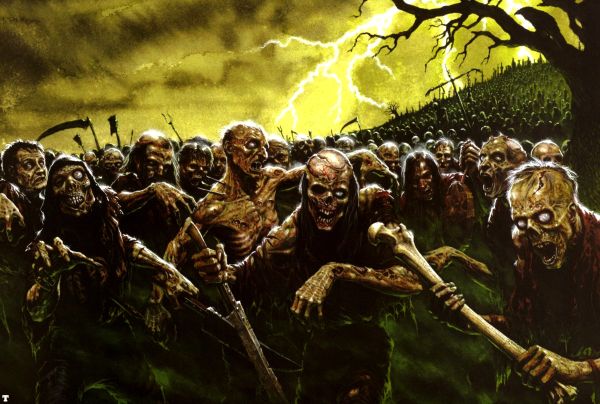Feral Zombie Plague

Most people in the typical D&D 5E world are commoners (MM, p. 345). A commoner is likely to lose initiative to a feral zombie. Even if the commoner wins initiative, he or she is unlikely to survive the first round of combat against a feral zombie. The feral zombie is only 20% likely to miss a commoner with an attack, and its claws are going to take a commoner to 0 hit points with one successful attack. The commoner is 60% likely to be infected by the feral zombie’s claw attack. Say one feral zombie breaks into a household in which five commoners live. All of the commoners are killed. Four hours after the attack, one feral zombie has become four feral zombies (with three-fifths of the dead commoners becoming new feral zombies). In a commoner-rich environment, such as a city, the presence of a pack of feral zombies quickly becomes a serious threat.
That major urban’s center first line of defense, the guard (MM, p. 347), is also a poor match against a feral zombie. A pouncing feral zombie can kill a guard in one round about half the time, and the guard is unlikely to survive a second round of combat against a feral zombie. The city’s first response to the feral zombies is going to fail, and every guard killed is 55% likely to become a new feral zombie.
Since feral zombies abhor sunlight, the majority of attacks occur after sunset. During daylight hours, feral zombies move into hiding. They aren’t inactive, however. Defenders who move into an infected area to root out the monsters still have a fight on their hands as they move from house to house, shop to shop, sewer tunnel to sewer tunnel. Meanwhile, the majority of those injured but not killed are suffering the effects of feral zombie infection. Many of them are dead six hours after being attacked, and the initial attacks (at least) are likely to overwhelm the city’s healing capabilities.
A group of adventurers using the city as its base of operations could depart on some heroic endeavor and return days later to find the city overrun with undead monsters. The adventurers could also face problems related to refugees who flee the city with infected friends and family, hoping to find succor in a nearby town and bringing the infection with them to a new location. In cases where the nearest other community to is too far to reach before the infection kills its host, the adventurers then must deal with feral zombies running loose in the countryside, preying on farmers and travelers. As the plague spreads, society breaks down. Structures that nourished communities become compromised, and people become desperate. Opportunists loot homes and shops, and even otherwise decent people are more likely to take drastic steps to survive and protect their loved ones. Law and order give way to what Jack London called “the law of the club” (see chapter two of The Call of the Wild).
And, of course, D&D being a fantasy game full of monsters, strange cults, and dark gods, the feral zombie outbreak could have sinister origins. Cultists and cult fanatics (MM, p. 345) under the sway of evil priests (MM, p. 348) direct the chaos. They smuggle feral zombies into new locations. Masquerading as beneficient helpers, they finagle their way into positions of trust and authority within populations of survivors. If the adventurers figure out what’s going on, they find themselves opposed by good but desperate people who have been duped by the forces of evil. Before the adventurers figure out what’s going on, they themselves might number among the dupes, embarking on missions of mercy that really expand the influence of those who seek to spread the undead plague. Meanwhile, other groups and creatures inimical to civilization muster at the borders of the affected regions. When the center fails to hold, the frontiers run the risk of collapsing as well.
One way to outline the horror unleashed by a single pack of feral zombies set loose in a city comes from the wonderful RPG Dungeon World, which uses a technique called a front. If you’re not familiar with fronts, check them out by clicking here. A front “is a collection of linked dangers—threats to the characters specifically and to the people, places, and things the characters care about.” If the characters don’t intervene, the front progresses to its natural conclusion, usually ending in widespread death and destruction.
A series of zombie plague adventurers can be started as two or three types of dangers. The most obvious type of danger is the Horde, described at the aforelinked site. Combine the Horde danger with an Ambitious Organization and Arcane Enemies, and you’ve got a wealth of material that can be spun into several adventures to challenge any group of characters.

Leave a Reply